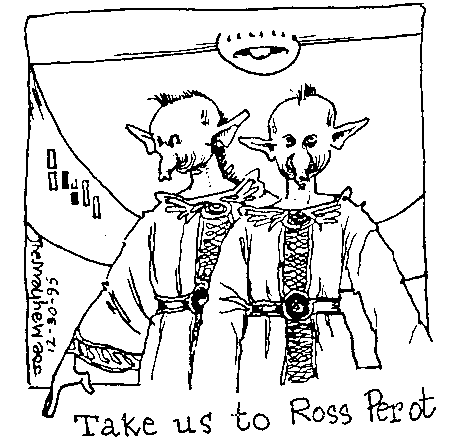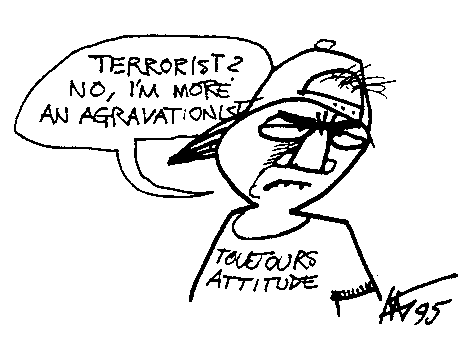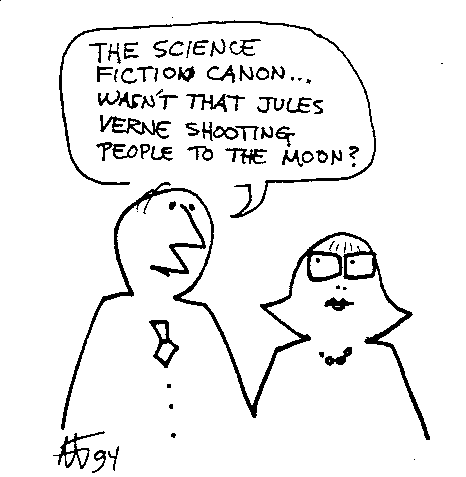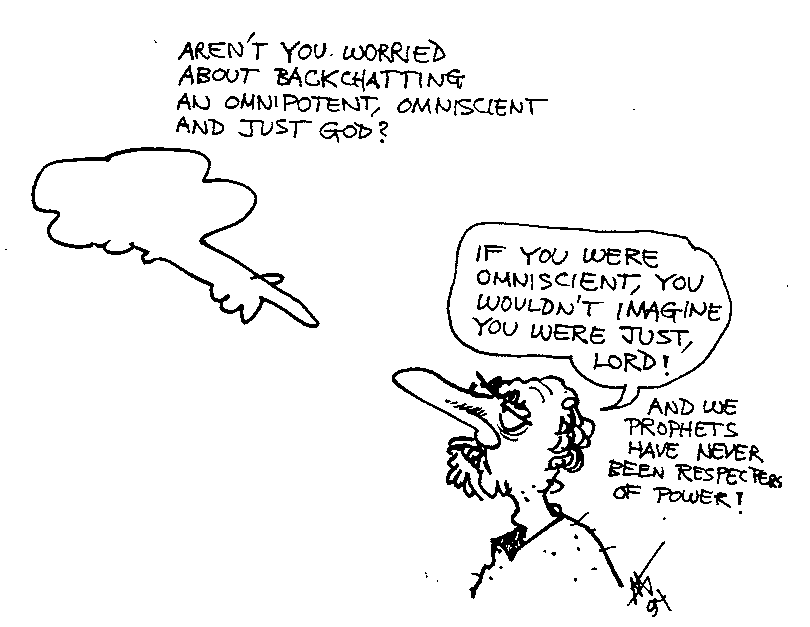

The Official Newsletter of the Washington Science Fiction
Association -- ISSN 0894-5411
Edited by Joe Mayhew
Fantastic Journey
WSFA Minutes December 15th at Ginter's
People with Powers II
My Vermeeriad
Snow White and the Seven Deadly Sins
Space Tom
The World Fantasy Convention generally takes place on the weekend nearest to Halloween. Since no masquerades or role-playing games are permitted, the gathering is basically an opportunity for writers and serious readers to talk to each other about books. This year the convention took place in Baltimore, and I went up for a Saturday.
Once registered, I dropped in on a panel discussion devoted to the short story, featuring Lucius Shepard, Terry Bisson, and Howard Waldrop, the con's three guest of honor. Should these names be merely names to you, go immediately to your bookstore and ask for Shepard's THE JAGUAR HUNTER , Bisson's BEARS DISCOVER FIRE , and Waldrop's ALL ABOUT STRANGE MONSTERS OF THE RECENT PAST. If you can't find these titles, take any you can get and keep checking the used bookshops for others. Shepard writes like Joseph Conrad on speed; Bisson can charm your toes off, and Waldrop is a Texas style magic realist (see "Ike at the Mike," in which Sen. Elvis Presley attends a concert at the White House honoring the great old bluesman Dwight Eisenhower, or God's Hooks!" wherein John Bunyan and Izaak Walton go fishing for Leviathan; both are in the hard-to-find but priceless collection, HOWARD WHO?)
Of the many rapid-fire, often very shrewd comments about the writing of fiction, I especially liked Howard Waldrop's definition of the short story and the novel: A short story is "about the most important thing that will ever happen to that character in his life"; while a novel chronicles "the most important time in a character's life." Waldrop then added that, by the story's end, "there must be some cost to the character."
Later, in a hallway, I overheard Joe Haldeman exclaim, "The guy asked, `What's the world coming to?' I answered, `How should I know? I'm only a science fiction writer.'" In the dealer's room, shelves weighty with expensive treasures, I found and bought proofs of Angela Carter's brilliant novel NIGHTS AT THE CIRCUS, surely a masterpiece if anything is. Later, over dinner, Edward Bryant, the convention's toastmaster, explained to me just how he used his own blood to stamp a lizard design of special editions of FETISH. At various cocktail parties, one might chat with novelists Elizabeth Hand, Gene Wolfe and Stephen Donaldson, ONMI editor Ellen Datlow, critic John Clute, steam punk pioneer Tim Powers, and many others. At one point Michael Swanwick (THE IRON DRAGON'S DAUGHTER) insisted, clear-eyed and without the apparent encouragement of drink, that Gardner Dozois's opening pages to the forthcoming "CITY OF GOD" might well be "the best 4,000 words ever written in science fiction." Presumably the remaining words aren't half bad either. By the end of the day I just wanted to rush home and read.

Attending: Pres. Covert Beach, VP. Sec. & 98 Chair Joe Mayhew, Treas. & 96 Chair Bob MacIntosh, Trustee John Pomeranz, 97 Chair Mike Nelson, Eric Baker, Bernard Bell, Steven desJardins, Alexis Gilliland, Lee Gilliland, Erica Ginter, Steven Glick, Joe Hall, Bill Jensen, Richard Lynch, Nicki Lynch, Keith Marshall, Walter Miles, Barry Newton, Lance Oszko, Evan Phillips, Rachel Russell, George R. Shaner, William Squire, Lee Strong, Michael J. Taylor, Ronald C. Taylor, Michael J. Walsh, Madeleine Yeh.
The meeting was called to order at 9:15 by President Beach. The Fifth Friday still had no host, there was no other outstanding agenda.
Bob MacIntosh announced a treasury balance of $7,028.58.
NO BUSINESS WAS CONDUCTED
Lee Strong plugged the recently completed John Ellis Production "TWILIGHT OF THE DOGS" in which he and several other local fen appear (i.e. Keith Marshall, Ray Ridenour, Susan Cohen, Gary Romain, Walter Miles, Martin Wooster and of course, Lee Strong) The film will debut at Evecon on the 13th of January, 1996.
The meeting was adjourned at 9:31.
@@@@@@@@@@@@@@@@@@@@@@@@@@@@@@
The WSFA JOURNAL is the official publication of the Washington Science Fiction Association, Inc., a SF related social club in the Greater Washington, DC area. The WSFA JOURNAL is produced by Joe Mayhew, club Secretary, for each meeting, that is, twice monthly for the First and Third Friday of each month, usually in about 50 copies.
TWJ exists to inform and entertain WSFA as well as to provide a record of its business and activities. It accepts articles, artwork -- just about anything which might interest its readers, with the following exception: Joe will not publish items which slander or ill-use people, opinion on current US politics, professional sports schedules, or deliberate misinformation. TWJ is produced on an IBM format computer using Word Perfect 5.1, reproduced xerographicly and thus is very happy to accept articles on diskette, or via E.Mail [GEnie = J.Mayhew4@genie.geis.com]
As TWJ produces Address and Telephone lists from time to time, please make sure Joe knows your current information.

Although the characters in Hoffman's world of the Locke, Bolte, and Keye families are fantasy, their closest cousins are science fiction -- Zenna Henderson's The People. These stories, originally published in the 50's and 60's, and collected as PILGRIMAGE: THE BOOK OF THE PEOPLE and THE PEOPLE: NO DIFFERENT FLESH are now collected, complete with four stories not previously collected (and one that was included in a non-People collection) as INGATHERING: THE COMPLETE PEOPLE STORIES OF ZENNA HENDERSON (NESFA Press, $25)
So who are the people? They look exactly like humans but they come from another world, called the Home, and have special gifts and persuasions that allow them to levitate, sense and sort, heal, and call lightning from the air. There is a basic goodness, what we in the cynical '90s would call naivety, about the People. There are no evil People, some of the kids can get into misadventures (but always with a good reason) one town of them has turned secretive out of fear of how Earthlings first treated them, and there is one case, one, of a selfish adult. Yet, one of their gifts, a racial memory, is the cause of an underlying sadness to these tales. They remember the destruction of their home as if it happened to them; they remember how they were first treated on Earth, hunted and feared by ordinary humans.
Most of the stories revolve around two themes, (1) the arrival of the People and how they are treated by the humans who encounter them and (2) the struggle of individual members of The People to find the others. But there are enough variations on these themes, and stories that do not quite fit these categories, so the reader does not become bored. Many of these stories, especially the early ones, revolve around teachers who are the only Outsiders who get close enough to penetrate The People's secrets.
I personally believe that the stories collected in the first part, PILGRIMAGE are the strongest, especially the first "Ararat" about the arrival of a new teacher, an Outsider, and the town's struggle to cover up so the teacher doesn't realize their strangeness. "Pottage" in which "Ararat" is inverted and the whole town lives in fear except the teacher. "Gilead" features a boy and girl of The People discovering their powers and their heritage (slightly weaker than the others but still good enough so that when I first read it in an anthology I started looking for the rest.) "Wilderness" where a teacher with strange powers but no memory of The People meets a member of The People who remembers everything except how to find them. "Captivity" where a Huckleberry Finn type child has strange musical gifts. Other strong stories include "Deluge" about The Home and The Crossing, "Angels Unawares" about pioneers in 1890 who help survivors of the crash and about religious fanatics who try to kill them. "Troubling of the Waters" a companion story about another survivor is slightly less strong. One of the uncollected stories, "Tell Us A Story" is similar to "Troubling" also featuring survivors of the crash who don't understand how to survive on this planet and a hostile father-figure. Two other stories feature space travel "Shadow on the Moon" about children who discover an old man building a space ship to take his son to the moon and "The Indelible Kind" about a child with a rather odd learning disorder.
Only one story does not work, "Katie-Mary's Trip" an attempt to bring The People into the '60s using the style of the 60s instead of Henderson's normal, plain style. Of the other new stories, "Michal Without" has a wonderful engaging character in Michal and a twist on the discovery of The People theme. "That Boy"
Henderson's greatest strength is combining the mundane and ordinary with the extraordinary but without the two warring with each other.
"I sighed and turned my back on the room, wandering my eyes up the steepness of Black Mesa as it towered above the school, trying to lose myself from apprehension, trying to forget why I had run away -- nearly five hundred miles -- trying to forget those things that tugged at my sanity, things that could tar me loose from reality and set me adrift... Adrift? Oh, glory! Set me free Set me free! I hooked my pointer fingers through the old wire grating that protected the bottom of the window and tugged sharply. Old nails grated and old wire gave, and I sneezed through the dry acid bite of ancient dust."
If you ever thought you were different from everyone else (and what sf reader hasn't); if you ever wondered what it would be like to have special powers; if you ever wanted a family that understood you and accepted you (yes, Henderson taps into that vein too) then you owe it to yourself to discover The People through INGATHERING. I cannot rate it highly enough.
Not all those with special powers will be as good, as harmless as The People. Some may have drastic consequences, even if unintentional, on the world. This is the case in Nancy Kress' BEGGARS IN SPAIN (Avon Books) a story of a group of people genetically engineered to not need sleep. The first and strongest part, originally a separate novella, tells of the girlhood of Leisha, one of the first Sleepless and her twin who is a normal human. Raised as a rich girl in an age of limitless energy, Leisha has a strong faith in the law and in the rationality of humans, even sleeper humans. But, the other Sleepless do not share her views and as they use their high intelligence and eight extra hours a day to accumulate money and power, face growing resentment from ordinary humans especially when it is learned that the Sleepless would have much longer lives than other humans
Fortunately, this hatred is explained as more than just "we hate you because you are different." The theme of beggars in Spain is used to express what the well off owe to those less fortunate. The Sleepless, confronted with acts of hostility and violence, want to withdraw into their own community.:
"What if you walk down that street in Spain and a hundred beggars each want a dollar and you say no and they have nothing to trade you but they're so rotten with anger about what you have that they knock you down and grab it and then beat you out of sheer envy and despair? ... The point is: What do you owe the beggars then? What does a good Yagaiist who believes in mutually beneficial contracts do with people who have nothing to trade and can only take ...
In the most objective terms you can manage, what do we owe the grasping and nonproductive needy?"
"What I said originally, Kindness. Compassion"
"Even if they don't trade it back? Why?"
"Because..." She stopped.
"Why? Why do law-abiding and productive human beings owe anything to those who neither produce very much nor abide by just laws? What philosophical or economic or spiritual justification is there for owing them anything? Be as honest as I know you are."
Leisha put her head between her knees. The question gaped beneath her but she didn't try to evade it. "I don't know. I just know we do."
Leisha may not be able to answer the question but the author, through the plot, provides an answer by the time the original story is over. This gives the author a problem, what to do with the rest of the book once the original idea is finished?
The second section deals with the rise of the "We Sleep" movement that produces substandard goods that normal people buy to show opposition to the Sleepers who they fear are taking over through economic strength. It also features a trial of the leader of the Sleepless Sanctuary movement, who believes the Sleepers should withdraw from the normals. The third section, the weakest of the four, takes place 25 years later after an economic collapse has created a welfare state gone haywire with a few "donkeys" supporting the majority "livers" who just existed in leisure. Leisha runs a foundation for trying to give livers a good education but with few takers. However, just as Sanctuary (now an orbital satellite inhabited only by Sleepless) plans to secede from the U.S. (which taxes it at the 90 percent rate) a ragged ten year old boy visits Leisha to learn what he needs to do to take over Sanctuary. The fourth section returns to the themes and vivid characterization of the first part. Sanctuary has created Super Sleepless, smarter and with more powers than the normal Sleepless. These children must decide if history should repeat itself and those with more abilities will choose to use their gifts solely for their own profit.
Characterization is a little uneven here, although very strong in the original story, for the rest of the book only Leisha, her sister, Drew, and some of the Sleepless really standing out as people. And for the whole second half, Leisha is basically a passive figure, withdrawn from the world and reacting to But the strength of the book's theme and argument make this work. The book answers the questions it raises, what to do about the beggars in Spain, but in such a way that it forces the reader to think and make his own decisions. People on both sides of the welfare debate will find ideas here to challenge their beliefs. I recommend that everyone buy this book, read it, and then send it to their Congressman with a note saying "Read this before you vote on welfare."

About 28 of the 37 paintings attributed to one of the world's most venerated painters, Jan Vermeer, had been brought to the National Gallery of Art in DC. People from all around the world were very interested and many planned on coming to see it because this is a one in a lifetime event, perhaps never to happen again. However, it was poorly timed, as the Congressional budget tantrum resulted in closing down the Smithsonian until income from the skating rink in Hell pays off our national debt, or something like that. They tried to close the Vermeer exhibit down but they failed. Private money, I believe from United Technologies, re-opened it until the last of 1995 - no word as to whether this extraordinary collection will be seen at the NGA after then. The Mauritshuis and other lenders are rather put off by the closing and are mumbling about withdrawing their stuff.
To see it, one had to go down to the NGA, wait in line, get tickets and then return at the time designated on the tickets, later that day. The NGA Vermeer show was open from 10 AM to 7PM.
There's little if any parking available now on the Mall, but there is a Metro stop about four blocks away behind the National Archives, so left home about 8:15, drove to the Greenbelt Metro station, parked, got on the GREEN line (which is strangely incomplete), took it as far as it goes to Ft Totten, transferred to the RED line as far as Chinatown, and got back on the GREEN line to the Naval Memorial-National Archives stop, waddled over to the NGA got around 10 AM. There was a line. By then it extended out the center of the building on the Constitution Avenue side, down to the end of the building (about a city block), the full length of the building's end (mabye 2 blocks) and then another block back to the grand stairway on the Mall side. Despite the mugging cold, I got in line and waited. I had promised my sister-in-law to get tickets for her, her sister and brother-in-law who were visiting from Denver. I noticed a fair number of Asiatics in line, but no African types. Actually, it took some time before I realized it, however, I had lots of time. The line moved in fits and starts until I passed inside the gigantic bronze doors of the NGA into its lobby, which was packed like a computer printer ribbon case with a folded snake of people about 7 to 9 folds deep. How much longer, Lord? Once inside the inner glass doors, the line went up the great marble stairs to the rotunda. A number of lines wound round the Bernini fountain - some were waiting to see the show, some to get tickets. Everything but the Vermeer show was closed so there were partition blocking one's view of the rest of the Gallery. Our line went three-quarters of the way around the Rotunda and down the eastern great hall to a small desk just outside the atrium. After around two and a half hours in line, I got the tickets for admission between 5:30 and 6:00 that evening. They allowed six. So, we got a loyal group of six together. My Brother Bill drove us in his van, with the idea that if he couldn't find a parking place, he would wait for us. He is a very generous soul, but he also had a bad case of bone spurs in his feet which were killing him that day, so he had mixed feelings about walking around on marble floors just then. So he dropped us off at the Conn Ave door. Once inside we proceeded to our 5:30-6:00 queue. Much to my surprise, the very long line 5:00 line which was there when we arrived at about 5:15 was gone by about 5:25. We actually got into the show around 5:40. We would be allowed to stay in the show until 7:00 when the NGA closed, and as there were only 28 pictures to see, that seemed enough time.
There were several rooms set aside for the exhibit. Most held only three pictures, some four. Any more pictures in a room would have been unbearably crowded. While most of Vermeer's pictures are rather small, the audience was vast and very interested. No casual browsers, but people drinking in what they had come to see. Many had come a very long way.
Some of the best Vermeers are questioned, some of his early paintings ought to be. But his best are worth the trip. Photos help, but there are qualities in Vermeer's paintings which don't seem to be pass on through photography, and certainly not through screen separation and mass printing. Vermeer was a buddy of Leeuwenhouk, the Lensman. He used lenses in his camera obscura to make very precise focus fields, which together with his carefully managed perspective, glazing techniques and other magic produces a picture to be looked into rather than at. His paintings "the Cartographer" and "the Astronomer" are likely to have been portraits of Leeuwenhouk. Some art historians think they're pictures of Vermeer himself. I doubt it, as artists who do their own portraits usually do a lot of them.
Vermeer is how people know him, however, according to the baptismal records in Delft's Nieuwe Kerk, his parents were "Raynier Jansz" and "Digna Baltenz." He was baptised as Joannis- which of course is a latin form for "John". The Letter J not being completely separated from the letter I in those days, it might have been "Ioannes" He signed some of his pictures simply "I Meer". The Dutch call him Jan Vermeer, or "Ver Meer" or even "van der Meer" His first name is quite commonly given in German, "Johannes". Vermeer was the president of the local artist's guild, a businessman who dealt in other people's paintings, a convert to Roman Catholicism (a move he made before marrying his wife, but which seems to reflect a real spirituality on his part) and sadly not very successful in his business activities. He painted too slow and carefully to get rich at it, and didn't do the lumpen genre stuff which was then in vogue. His paintings are not only carefullly focused for depth, but his subjects seem captured in a split second. Their posture and expression usually suggest -very strongly- thought, a moment of discovery or reflection. Not usually the stuff of wall decorations.

Once upon a time there was a posturing of editors who lived in a publishing cottage nestled beneath the boughs of Pulp Forest. Their names were Pride, Covetousness, Lust, Envy, Gluttony, Anger and Sloth.
Several times a week some fair ms would show up at their door begging asylum from the wicked step-critic who was determined to be fairest in the land at her expense. Each ms would be welcomed into their cottage as a menial only to be promptly done in by some shabby ruse.
One was killed by a poisoned blurb, another was blythely deconstructed, yet another was bludgeoned out of context.
The Editors would bury each murdered ms on the remaindered table with tear-filled eyes hoping that the next little ms to show up at their door would not suffer a similar fate.
But they always did. Sure as a check in the mail, the next poor little ms would be lumped by fatal comparisons or misquoted with malice. And so it went.
Then, one day, as the latest slaughtered ms lay dead on their house's backlist, a handsome prince of a reviewer kissed her on page one. Suddenly her sales shot up and she went into several beautiful editions.
Of course, this is a fairy tale. Nobody has backlists any more.
